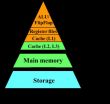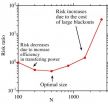(Press-News.org) Washington, D.C.—Global health funding hit an all-time high of $31.3 billion in 2013, five times greater than in 1990. Yet with 3.9% growth from 2012 to 2013, the year-over-year increase falls short of the rapid rates seen over the previous decade, according to new research by the Institute for Health Metrics and Evaluation (IHME) at the University of Washington being published online in a web first edition on April 8 by Health Affairs.
As funding from many bilateral donors and development banks has declined, growth in funding from the GAVI Alliance, the Global Fund to Fight AIDS, Tuberculosis and Malaria, non-governmental organizations, and the UK government is counteracting these cuts. Global health funding remains small relative to what high-income countries spend on their own health, representing only 1% of these countries' health expenditure.
The findings will be presented today by IHME Director and report co-author Dr. Christopher Murray at the Center for Strategic and International Studies (CSIS). The results will be published online in Health Affairs and in the fifth annual edition of IHME's health funding series, Financing Global Health 2013: Transition in an Age of Austerity.
The findings will also be available in a new online data visualization tool, and the data from the study will be available on IHME's website at healthdata.org.
In addition to providing a detailed picture of donors' global health spending, the report tracks development assistance for different health issues up to 2011, the most recent year data are available. IHME found that funding for maternal, newborn, and child health increased by nearly 18% between 2010 and 2011, reaching $6.1 billion.
"Donors' continued support for increased spending on maternal, newborn, and child health reflects the global sense of urgency to meet the Millennium Development Goals by 2015," Dr. Murray said.
For the first time, IHME measured health funding for tobacco control, which totaled $68 million in 2011. In comparison, funding for HIV/AIDS, the health issue receiving the most funding in 2011, was 113 times as large as funding for tobacco control.
The report found gaps between donor funding and disease burden in most regions, particularly with respect to non-communicable diseases (NCDs). Funding related to this category expanded from 2010 to 2011, yet while NCDs are a prominent and rising portion of disease burden in the developing world, they are not a primary focus of development assistance for health.
"The Global Burden of Disease shows steady growth in the burden of non-communicable diseases in all regions except sub-Saharan Africa," said study co-author Dr. Joseph Dieleman, who leads health financing research at IHME. "There is relatively little development assistance for health in these countries for NCD-related programs."
IHME also compared development assistance for different health issues to disease burden. Even though sub-Saharan African countries tended to receive the greatest volume of malaria assistance, for example, as a whole they received less than $60 of malaria funding for every year of healthy life lost to malaria between 2006 and 2010. In comparison, Latin America and the Caribbean received nearly $2,000 of malaria funding per year of healthy life lost during this same period.
For NCDs, the funding per year of healthy life lost was much smaller, less than 50 cents in South Asia from 2006 to 2010, and just over $2 in Latin America and the Caribbean.
Even though much of the global health community's attention is focused on development assistance for health, IHME researchers found that developing countries on average spend 20 times more of their own resources on health than they receive in assistance. Excluding donor assistance, government health expenditure amounted to $613.5 billion in 2011. This spending grew 7.2% between 2010 and 2011.
In most countries, donor funding made up less than 10% of total government spending on health. In certain Asian and sub-Saharan African countries, however, development assistance for health accounted for more than half of total government health spending.
INFORMATION:
Other major findings from the report:
While the United States continued to be the single largest channel of development assistance for health, at $7.4 billion, 2013 marks the second consecutive year of reduction in health funding from the US. US global health funding peaked in 2011 at $8.3 billion.
Across regional groupings, sub-Saharan Africa received the largest portion of development assistance for health. In 2011 (the most recent year for which recipient-level estimates are available), sub-Saharan Africa's share was $8.8 billion, or 28.6% of total development assistance for health.
The spending of public-private partnerships also grew substantially in 2013. GAVI's disbursements reached an estimated $1.5 billion in 2013, a 32% increase relative to 2012 levels. Funding from the Global Fund to Fight AIDS, Tuberculosis and Malaria grew 16.8%, to $4 billion, from 2012 to 2013.
Many of the countries with the highest disease burdens do not receive the most development assistance for health. Of the countries with the top 20 DALYs, only 13 are among the top 20 recipients of global health funding.
The Institute for Health Metrics and Evaluation (IHME) at the University of Washington provides rigorous and comparable measurement of the world's most important health problems and evaluates the strategies used to address them. IHME makes this information freely available so that policymakers have the evidence they need to make informed decisions about how to allocate resources to best improve population health.
Media contacts:
Rhonda Stewart
stewartr@uw.edu
+1-206-897-2863
William Heisel
wheisel@uw.edu
+1-206-897-2886
Global health funding reaches new high as funding priorities shift
Support for maternal and child health increases; public-private partnerships and NGOs play a larger role; government spending on domestic health rises sharply
2014-04-08
ELSE PRESS RELEASES FROM THIS DATE:
UNC researchers find genetic trigger for RSV-induced infant hospitalizations
2014-04-08
April 8, 2014 CHAPEL HILL, N.C. – Researchers at UNC School of Medicine have pinpointed a viral protein that plays a major role in making respiratory syncytial virus (RSV) the most common cause of hospitalization in children under one year of age.
The discovery, published April 8 in the Journal of Clinical Investigation, is the first step toward identifying better diagnostics and potential treatments for an infection that strikes nearly all children before they reach the age of three and causing severe disease in 3 percent of infected children. RSV infection leads to ...
The double whammy of multiple sex partners and drinking in HIV/STI prevention
2014-04-08
PHILADELPHIA (April 8, 2014) – The cartoon character Homer J. Simpson once said "Alcohol: The source of, and solution to, all of life's problems."
The sage of the ubiquitous and fictional town of Springfield may have hit the nail on the head when it comes to human immunodeficiency virus (HIV) and sexually transmitted infections (STIs) counseling and prevention. The more you drink and/or the more sex partners you have, the less likely you are to engage in HIV-prevention programs.
This rather grim assessment came about from the study, "Barriers to accessing HIV-prevention ...
Language structure… you're born with it
2014-04-08
Humans are unique in their ability to acquire language. But how? A new study published in the Proceeding of the National Academy of Sciences shows that we are in fact born with the basic fundamental knowledge of language, thus shedding light on the age-old linguistic "nature vs. nurture" debate.
THE STUDY
While languages differ from each other in many ways, certain aspects appear to be shared across languages. These aspects might stem from linguistic principles that are active in all human brains. A natural question then arises: are infants born with knowledge of how ...
Advanced warning systems increase safety at intersections, study shows
2014-04-08
Most drivers have experienced a traffic signal that turns yellow just as they approach an intersection, which makes it difficult for them to decide whether to stop or proceed through it. The wrong choice in this situation, known as the "dilemma zone," may lead to crashes, especially at high-speed intersections.
A major factor making driving difficult is hazards that are sudden and hard to predict. Roadside and in-vehicle display warning systems may help drivers handle these hazards by predicting their occurrence and providing advanced warning to the driver, according ...
Lipid levels during prenatal brain development impact autism: York U study
2014-04-08
In a groundbreaking York University study, researchers have found that abnormal levels of lipid molecules in the brain can affect the interaction between two key neural pathways in early prenatal brain development, which can trigger autism. And, environmental causes such as exposure to chemicals in some cosmetics and common over-the-counter medication can affect the levels of these lipids, according to the researchers.
"We have found that the abnormal level of a lipid molecule called Prostaglandin E2 in the brain can affect the function of Wnt proteins. It is important ...
Kinesin-5 structure opens cancer drug targets
2014-04-08
VIDEO:
Kinesin-5 plays a crucial role in cell division by allow microfilaments to slide past each other. The kinesin-5 structure shows a central rod connecting two motor units that walk along...
Click here for more information.
The structure of a key part of the machinery that allows cells to divide has been identified by researchers at the University of California, Davis -- opening new possibilities for throwing a wrench in the machine and blocking runaway cell division in cancer.
"The ...
Phase II trial of efatutazone shows challenge of matching treatment to population
2014-04-08
Work at the University of Colorado Cancer Center led to phase II trial of efatutazone with erlotinib in patients with refractory non-small cell lung cancer. Results are reported today at the American Association for Cancer Research (AACR) Annual Meeting 2014. While efatutazone did not improve the efficacy of erlotinib in this trial, researchers hope lessons from the trial will allow them to make better future use of the drug or other drugs in its class.
"In oncology and especially in lung cancer, everything is personalized. We're exploring different molecular markers ...
Glucosamine promotes longevity by mimicking a low-carb diet
2014-04-08
Glucosamine has been freely available in drugstores for many decades. It is widely used to treat arthritis and to prevent joint degeneration. Moreover, glucosamine is known to delay cancer growth. In addition, glucosamine reduces metabolism of nutritive sugars, as was already shown some 50 years ago.
In 2007, Michael Ristow showed that too much nutritive sugar shortens the lifespan of roundworms, a widely studied model organism in ageing research. Conversely, impairing carbohydrate metabolism in these worms was capable of extending lifespan [reference 1]. Unfortunately, ...
Future computers that are 'normally off'
2014-04-08
WASHINGTON D.C., April 8, 2014 -- If a research team in Japan gets its wish, "normally off" computers may one day soon be replacing present computers in a move that would both eliminate volatile memory, which requires power to maintain stored data, and reduce the gigantic energy losses associated with it.
Most parts of present computers are made with volatile devices such as transistors and dynamic random access memory (DRAM), which loses information when powered off. So computers are designed on the premise that power is "normally on."
Back in 2000, the concept of ...
Is the power grid too big?
2014-04-08
WASHINGTON D.C., April 8, 2014 -- Some 90 years ago, British polymath J.B.S. Haldane proposed that for every animal there is an optimal size -- one which allows it to make best use of its environment and the physical laws that govern its activities, whether hiding, hunting, hoofing or hibernating. Today, three researchers are asking whether there is a "right" size for another type of huge beast: the U.S. power grid.
David Newman, a physicist at the University of Alaska, believes that smaller grids would reduce the likelihood of severe outages, such as the 2003 Northeast ...
LAST 30 PRESS RELEASES:
Structure of dopamine-releasing neurons relates to the type of circuits they form for smell-processing
Reducing social isolation protects the brain in later life
Keeping the heart healthy increases longevity even after cancer
Young adults commonly mix cannabis with nicotine and tobacco
Comprehensive review illuminates tau protein's dual nature in brain health, disease, and emerging psychiatric connections
Book prepares K-12 leaders for the next public health crisis
Storms in the Southern Ocean mitigates global warming
Seals on the move: Research reveals key data for offshore development and international ecology
Sports injuries sustained during your period might be more severe
World's first successful 2 Tbit/s free-space optical communication using small optical terminals mountable on satellites and HAPS
Can intimate relationships affect your heart? New study says ‘yes’
Scalable and healable gradient textiles for multi‑scenario radiative cooling via bicomponent blow spinning
Research shows informed traders never let a good climate crisis go to waste
Intelligent XGBoost framework enhances asphalt pavement skid resistance assessment
Dual-function biomaterials for postoperative osteosarcoma: Tumor suppression and bone regeneration
New framework reveals where transport emissions concentrate in Singapore
NTP-enhanced lattice oxygen activation in Ce-Co catalysts for low-temperature soot combustion
Synergistic interface engineering in Cu-Zn-Ce catalysts for efficient CO2 hydrogenation to methanol
COVID-19 leaves a lasting mark on the human brain
Scientists use ultrasound to soften and treat cancer tumors without damaging healthy tissue
Community swimming program for Black youth boosts skills, sense of belonging, study finds
Specific depressive symptoms in midlife linked to increased dementia risk
An ‘illuminating’ design sheds light on cholesterol
Who is more likely to get long COVID?
Study showcases resilience and rapid growth of “living rocks”
Naval Research Lab diver earns Office of Naval Research 2025 Sailor of the Year
New Mayo-led study establishes practical definition for rapidly progressive dementia
Fossil fuel industry’s “climate false solutions” reinforce its power and aggravate environmental injustice
Researchers reveal bias in a widely used measure of algorithm performance
Alcohol causes cancer. A study from IOCB Prague confirms damage to DNA and shows how cells defend against it
[Press-News.org] Global health funding reaches new high as funding priorities shiftSupport for maternal and child health increases; public-private partnerships and NGOs play a larger role; government spending on domestic health rises sharply




